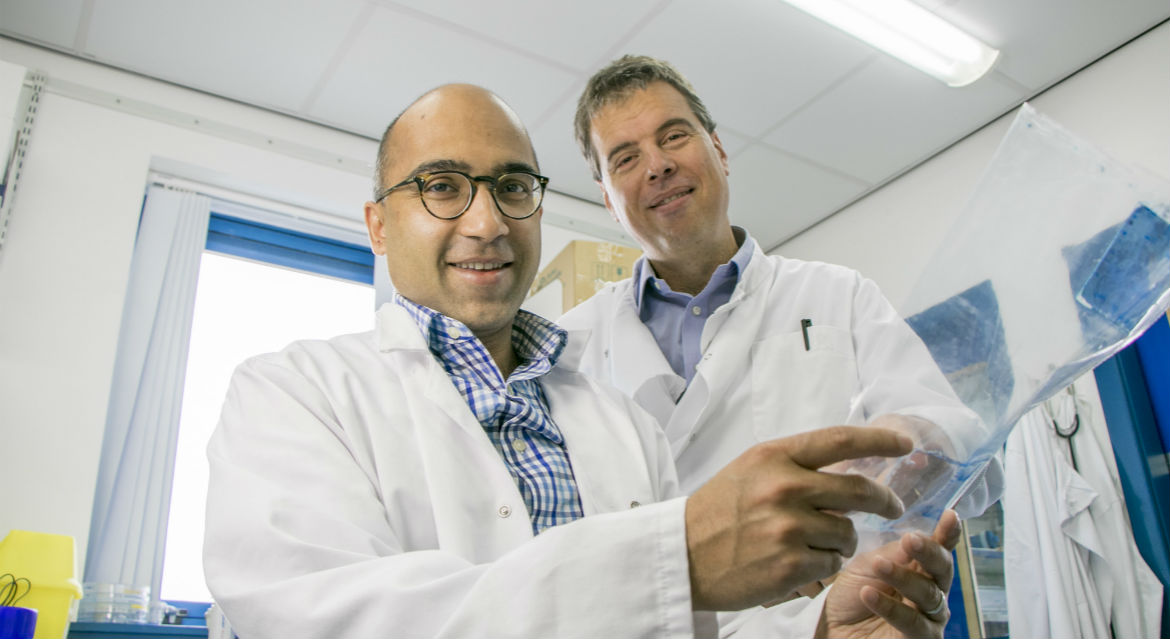Dundee scientists make Parkinson’s breakthrough
Published On Thu 5 Oct 2017 by Roddy Isles

Scientists at the University of Dundee have identified the structure of a key enzyme that protects the brain against Parkinson’s disease.
The result of a decade of work, the research team said that solving the 3D structure and inner workings of the PINK1 enzyme represented a major breakthrough.
“Solving the structure and workings of PINK1 gives us crucial insights in to how it exerts a protective role in Parkinson’s,” said Dr Miratul Muqit, Wellcome Trust Senior Clinical Fellow and Consultant Neurologist at the MRC Protein Phosphorylation and Ubiquitylation Unit (MRC-PPU) in the School of Life Sciences, who co-led the research team with Professor Daan van Aalten at the University.
“That knowledge can lead to the development of new drugs which could be designed to `switch on’ PINK1 to the benefit of patients with Parkinson’s.”
Professor van Aalten, a Wellcome Trust Investigator in the Division of Gene Regulation and Expression in the School of Life Sciences, said, “There has been great interest in directly targeting PINK1 as a potential therapy but without knowledge on the structure of the enzyme, this posed a major barrier. Our work now provides a framework to undertake future studies directed at finding new drug like molecules that can target and activate PINK1.”
Parkinson’s is a progressive degenerative brain disorder which to date remains incurable. Previous advances in genetics identified mutations in the PINK1 gene in patients with early-onset forms of Parkinson’s.
PINK1 encodes a special class of enzyme known as a kinase that plays a critical role in protecting brain cells against stress. In patients harbouring PINK1 mutations, this protective effect is lost leading to the degeneration of cells controlling movement that account for Parkinson’s symptoms.
Previous work had indicated that the main role of the PINK1 enzyme is to sense damage to the energy centres of cells known as mitochondria and then switch on a protective pathway involving the targeting of two key proteins, ubiquitin and Parkin, to reduce the damage. But how this occurred was unknown.
In the new research, published in the journal eLife, the team of Dundee scientists reveal that PINK1 has unique control elements not found in other enzymes of this class that explain how it targets ubiquitin and Parkin to exert its protective role in Parkinson’s.
“This provides detailed insights into how mutations carried by hundreds of Parkinson’s patients worldwide interrupt the function of the enzyme,” said Professor van Aalten.
“This is a good example of collaborative research resulting from scientists with different expertise working together. It is only with the hard work of several PhD students and postdocs that we have been able to make this transformative step in our understanding of how PINK1 works. As is often the case, having now solved this important problem, there are many new interesting questions on PINK1 that will direct our future research.”
Dr Muqit added, “Our research has been focused on defining the most fundamental aspects of the causes of Parkinson’s which we think will uncover new ideas for better treating the disease in the future.”
Michael Dunn, Head of Wellcome’s Genetics and Molecular Sciences team, said, “The PINK1 protein has been the focus of research all over the world, so this finding from the Dundee team is a fantastic step forward for the community. If we understand the structure of this protein, which holds so many clues into what goes wrong in Parkinson’s, it may help us develop novel drugs to protect against this devastating disease. Basic research is fundamental to understanding and treating many diseases and only by working in collaboration can we hope to make breakthroughs like this.”
Dr Nathan Richardson, MRC Head of Molecular and Cellular Medicine, said, “Discovering the fundamental structure of this protein is vital for understanding its cellular function and paves the way for the development of drugs to combat forms of early-onset Parkinson’s disease. This advance will also help reveal the molecular basis of genetic mutations in Parkinson’s disease, illustrating the merit of long term support for underpinning biomedical research.”
Professor David Dexter, Deputy Director of Research at Parkinson’s UK, said, “The PINK1 gene was identified as a key player by Parkinson's UK-funded researchers back in 2004. Drugs that can switch the PINK1/parkin pathway back on may be able to slow, stop or even reverse nerve cell death, not only in people who have these rare inherited forms of the condition, but also those with non-inherited Parkinson's.
“This research, for the first time, gives us a view of what the PINK1 protein looks like and how changes in the gene can prevent the PINK1 protein working properly. This knowledge is vital for developing drugs that can switch PINK1 back on, which has the potential to slow or even stop the progression of the condition, something current treatments are unable to do.”
The research was funded by the Wellcome Trust, Medical Research Council, Biotechnology and Biological Sciences Research Council, and Parkinson’s UK, including the Parkinson’s UK branches of Fife and Ayrshire.
The full paper can be viewed here: https://elifesciences.org/articles/29985
For media enquiries contact:
Roddy Isles
Head of Corporate Communications
University of Dundee
Nethergate, Dundee, DD1 4HN
Tel: +44 (0)1382 384910
Mobile: 07800 581902
Email: r.isles@dundee.ac.uk